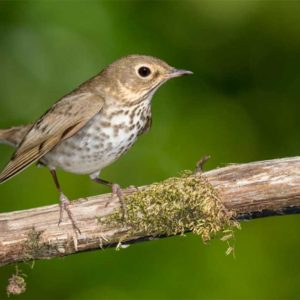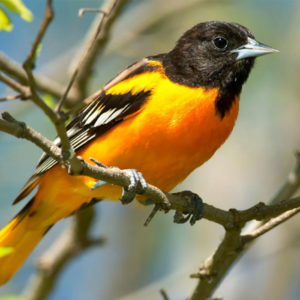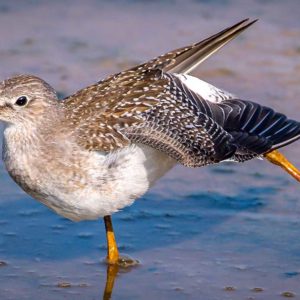Prince Edward County Field Naturalists, Nature Canada, and Ontario Nature have repeatedly urged the Ontario Government to protect Ostrander Point, and reject a proposed industrial wind energy project there. As a final decision on this project from the Ontario Ministry of the Environment is pending, it’s a good time to restate the key arguments for preserving this special place, and why the Green Energy Act would suffer a serious blow to its credibility if the project is approved.
The Green Energy Act has been successful in attracting industry and converting some of Ontario’s electricity generation from coal to renewable sources. It’s helped to create jobs. This is very good news.
However, by opening all Crown Landto development, an important government responsibility has slipped between the cracks: the protection of wildlife habitat. The most blatant and acute example of this is the proposed wind energy plant for Ostrander Point in Prince Edward County. Ostrander Point is a Candidate Area of Natural and Scientific Interest in the centre of the Prince Edward County (PEC) South Shore Important Bird Area (IBA). This IBA and the adjacent National Wildlife Area were designated globally significant under the congregatory (water fowl) species category and nationally significant under the threatened species category. Millions of birds migrate through the PEC South Shore in spring and fall — in even more dense concentrations than famed Point Pelee. In other words, this area is a super highway for birds, bats and monarch butterflies – the worst place to consider building 150 metre high wind turbines.
To approve this project, the Ontario government would need to ignore its responsibilities for species at risk and international agreements such as the Migratory Bird Convention Act. However, denying the project would send a positive message confirming the government’s commitment to protecting the environment, which is is one of the primary reasons for the Green Energy Policy. It would show the Act is being implemented with regard to wildlife and in a responsible way.
Nineteen Species at Risk are found at Ostrander Point. Fourteen Priority Species (birds that are declining rapidly) listed by Ontario Partners in Flight breed there. The continued ability of federally and provincially listed species at risk – Blanding`s Turtle (Threatened) and Whip-Poor-Will (Threatened) – to breed at Ostrander Point are seriously threatened by the construction of access roads and turbines.
Ostrander Point meets 11 criteria of Environment Canada`s definition of a site of “Very High Sensitivity” where turbines should not be sited. As EC Environmental Assessment Officer, Denise Fell has said: “This is one of the most important landfall sites in Ontario. Unique about this particular site is that birds are ascending and descending during migrations, whereas normally they migrate over the landscape in a broad front above the typical height of wind turbines. Since birds on migration in this area can therefore be found at tower height, and are typically very tired and stressed when descending, they may be more at risk of collision with wind turbines.”
Within the same flyway, just a little east of Ostrander Point, is the Trans Alta Wolfe Island wind plant is already in operation, and its casualty rate of 13.4 birds per turbine per year is about seven times the industry average in Canada, according to CANWEA. What’s more, the Wolfe Island turbines are very selective in the birds that they kill. Casualties are mainly swallows, including the rapidly declining Tree Swallow (70 percent decline in last 40 years) and Purple Martin (95 percent decline in last 40 years), as well as birds of preys such as Red-tailed Hawks. It is possible that the wind farm has killed off all of the local population of this species. Bobolink, a recently listed Species at Risk that has declined 80 percent in the last 40 years, has also been disproportionately killed.
That project’s thresholds for mortality rates are at the highest levelrecorded at any large wind facility in North America. Gilead proposes “adaptive management” thresholds for Ostrander Point at the same level. In other words, the highest casualty rate is the bar under which no mitigation is required.
Not only will the Gilead Project destroy two-thirds of the site’s significant wildlife habitat, it will be in place for 25-50 years, threatening the lives of birds and bats migrating through spring and fall, and permanently displace species that breed at Ostrander Point. Gilead states that it is a favourable site for their development because it “is in a relatively isolated part” of the County. This isolation from human use has created its value as wildlife habitat. The decline of most species is primarily due to human encroachment on habitat but also exacerbated by the effects of climate change. All the more reason to preserve this site, which has evolved over millennia as a crucial staging area for neotropical migrants. The nearby Prince Edward Point Bird Observatory records more birds than any other migration monitoring station in Canada.
The government’s Wind Atlas shows that the available wind is no higher at Ostrander Point than at hundreds of other locations. Approval of the Ostrander Point project will pave the way for the addition of another 29 turbines by WPD-Canada White Pines. All the projects proposed to date could total 60 turbines in the South Shore IBA, many on Provincial lands, and many on the narrow bird funnel known as the Long Point peninsula on which Ostrander point and Prince Edward Point are located.
Gilead claims that the project has been “designed to be sensitive to the wildlife of the area”.
But they have applied for permits to kill, harm and destroy the habitat of two endangered species: Blanding’s Turtle and Whip-poor-will. Gilead’s “most aggressive mitigation measures in North America to protect local and migrating species” consist of:
- Blanding’s Turtle – buying part of its significant wetland while destroying part;
- Whip-poor-will – hiring a graduate student to study its declining use of the habitat;
- Counting mortality numbers of migrating birds and bats for 3 years.
Developing wind energy in Canada, coupled with conservation measures to reduce all forms of fossil fuel consumption, is a good thing. But wind energy must not be produced at the expense of wildlife.
Wind turbines and wind farms should not be located in places – like Ostrander Point – where birds congregate, migrate and breed.All wind farm proposals should be subject to an environmental assessment prior to development in order to evaluate their impact on all wildlife, including birds and bats. And regulators such as the provincial and territorial governments should adopt policies and guidelines that exclude wind energy projects from Important Bird Areas and other areas that are known to be of importance to birds and bats.Let’s get wind power right in Ontario!



